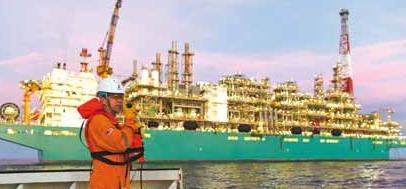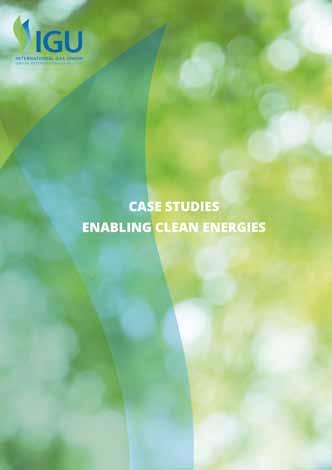
8 minute read
Surprise: Global gas price convergence has been happening since 2005
from IGU Magazine October 2016
by IGU
By Floris Merison
x Figure 1.
xv Figure 2. In the period 2005-2015, global natural gas markets have expanded and become more integrated through increased LNG trade, increased market-related pricing and gas hub development. From the basics of economic theory, it would be expected that global gas prices would converge. Research by the IGU Strategy Committee in cooperation with energy business school the Energy Delta Institute (EDI) now shows that global gas prices have indeed converged during this period. This is contrary to the conventional wisdom of global gas price divergence, based on a few regional gas price markers such as Henry Hub, NBP and Japanese import prices.
Market integration through growing LNG markets, increased market-related pricing and hub development are clear developments in the global gas market during the last ten years. Some good examples of improved conditions for gas market integration are shown in Figures 1 and 2, taken from the IGU World LNG Report, 2016 Edition, published by the IGU in April 2016.
Data from the IGU Strategy Committee show that global gas volumes sold against marketrelated (non-regulated) prices 1 have increased by more than 35% in the period 2005-2015 (Figure 3).
The economic theory of the Law of One Price states that, in a perfect market, potential arbitrage opportunities between countries are immediately exploited by market participants, leading to convergence to one single price. From this perspective, it would be expected that global gas prices should have converged, due to increasing arbitrage possibilities and further market integration.
1 Market-related pricing is largely gas-on-gas competition and oil price escalation, with an element of bilateral monopoly and netback pricing.
Increased non-long term LNG trade (contract duration less than five years)
1400
1200
1000
800
600
400
200
0
1995 1999 2003 2007 2011 Non long-term cargoes traded Countries importing non long-term LNG (right axis) Countries exporting non long-term LNG (right axis) 30
25
20
15
10 Number of countries
5
2015 0 Increased number of exporting countries in the global LNG market (market shares)
Percentage share 100%
80%
60%
40%
20%
0% 1990 1995 2000 2005 2010 2015
Qatar Trinidad Brunei Yemen Australia Algeria UAE US Malaysia Russia Norway Angola Nigeria Oman Eq. Guinea Egypt Indonesia PNG Peru Libya
Market-related gas pricing
Billion cubic metres 3000
2500
2000
1500
1000
500
0
However, the regular market view is that global gas prices diverged in this period. This is based on the developments of price benchmarks in only a few countries, such as the Henry Hub (US), NBP (UK) and Japanese import prices (Figure 4).
This graph shows that these prices diverged in the period 2008-2014. In 2015 they reconverged, but not (yet) to the extent of the years running up to 2007. These developments have been widely published and discussed in the gas industry.
The IGU Strategy Committee has been conducting Wholesale Gas Price Surveys for eight years in the period 2005-2015. The results of the 2015 survey, as well as the comparisons with previous surveys, were published in May 2016 in the IGU Wholesale Gas Price Survey, 2016 Edition.
Through conducting these surveys, a unique database has been built up, with data on gas price formation mechanisms, gas volumes, and annual average gas prices in 109 countries. The database enables analysis of different subsets of countries, categorised by properties such as price formation mechanism, region, and shares of imports.
This database has been used to shed more light on the apparent contradiction between the expectation of price convergence based on economic theory and market developments and the conventional market view of gas price
2005 2007 2009 2010 2012 2013 2014 2015 Regular market view: 2005-2015 price divergence
$/MBtu 18 16 14 12 10 8 6 4 2 0 2005 2006 2007 2008
Japan import price
2009 2010
NBP (UK) 2011 2012 2013
Henry Hub (US) 2014 2015
Data source: Argus divergence. The large number of countries available in the database, as well as the use of the coefficient of variation as a measure for price convergence provides new insights.
The coefficient of variation of prices of a dataset in a certain year is determined by the standard deviation divided by the mean value of these prices. The amount of absolute price variation (standard deviation) is thus measured relative to the average price in a certain year. A low coefficient of variation indicates a higher level of price convergence and vice versa. This measure is particularly suitable for datasets with a limited number of data points (eight years in our database), for a large number of price lines (109 countries in our database), and the ability to subdivide into subsets of countries with different mean gas prices.
Using the IGU database in this way, a trend of convergence can be recognised. In the period 2005-2015 the coefficient of variation of gas prices of 109 countries (including all significant gas-consuming nations) declined by 20%, indicating global gas price convergence (Figure 5).
In order to be able to trade to exploit arbitrage opportunities (leading to gas price convergence), countries should be connected to the global gas market. Connectedness to the global gas market could be realised through physical gas imports or through
zc Figure 3.
z Figure 4.
Global gas price convergence
90%
80%
70%
60%
50%
40%
30%
20%
10%
0% 2005 2007 2009 2010
Full IGU dataset (109 countries) 2012 2013 2014 2015 More price convergence for gas importing countries
Coefficient of variation 90%
80%
70%
60%
50%
40%
30%
20%
10%
0% 2005 2007 2009 2010
Full IGU dataset (109 countries) Subset: Gas-importing countries 2012 2013 2014 2015
z Figure 5.
zv Figure 6.
x Figure 7.
xv Figure 8. market-related pricing. We therefore looked at a subset of countries with a minimum level of gas imports (10%) and at a subset of countries with market-related prices. The result is as expected: the coefficient of variation is much lower in countries connected to the global gas market through physical imports and/or marketrelated prices (Figures 6 and 7).
When we look within the group of countries with gas imports as well as market-related pricing, we see that a subset of countries with oil price escalation as the main price formation mechanism shows more price convergence. This is not surprising, since these prices are largely all indexed to crude oil, gasoil and/or fuel oil prices (Figure 8).
For other market-related pricing mechanisms (such as gas-on-gas competition), the results are less clear, due to significant changes over the years in the number of countries in these subsets.
When we look at the different IGU regions, Europe is the only region with sufficient countries to make meaningful convergence calculations. Here we can conclude that there is more price convergence amongst gas-importing
More price convergence for countries with market-related gas prices
90%
80%
70%
60%
50%
40%
30%
20%
10%
0% 2005 2007 2009 2010 2012
Full IGU dataset (109 countries) Subset: Countries with market-related gas prices 2013 2014 2015 More price convergence for countries with oil-related prices
Coefficient of variation 90%
80%
70%
60%
50%
40%
30%
20%
10%
0% 2005 2007 2009 2010 2012
All importing countries with market-related prices Subset: Countries with oil price escalation in gas prices 2013 2014 2015
More price convergence within Europe than on a global level
Coefficient of variation 90%
80%
70%
60%
50%
40%
30%
20%
10%
0% 2005 2007 2009 2010 2012
All importing countries with market-related prices Subset: Europe 2013 2014 2015 More gas price convergence without (effectively disconnected) North America
Coefficient of variation 90%
80%
70%
60%
50%
40%
30%
20%
10%
0% 2005 2007 2009 2010 2012 2013 2014
All importing countries with market-related prices All importing countries with market-related prices (excluding North America)
countries with market-related prices within Europe than on a global level. This, again, is not surprising since intraregional trade of natural gas is usually easier and less costly than interregional trade (Figure 9).
In recent years, the shale gas revolution has made the IGU’s North America region (Canada, Mexico and the United States) practically independent from gas imports from outside of the region. As a result, the region has become effectively disconnected from the global gas market. Therefore, in our analysis we have looked at a subset without these three countries, which all have relatively low, Henry Hub-based prices. The conclusion is that the trend of global gas price convergence is more distinct when we exclude the data of these – effectively disconnected – North American countries (Figure 10).
In conclusion, this research shows that global gas prices have been converging since 2005. This is against the conventional market wisdom of gas price divergence in the years towards 2015, but in line with developments towards further integration of global gas markets, such as the growth of LNG trade and increased market-related gas pricing. Less surprisingly, we also conclude that there is more gas price convergence amongst countries (1) with market-related pricing, (2) which are connected with the global gas market through gas imports, (3) with oil-indexed gas prices, and (4) within Europe. The trend of global gas price convergence in the period 2005-2015 is more distinct when we exclude the data of the – effectively disconnected – North American countries.
Floris Merison is Manager Dispatching & Transport at GasTerra.
This research has been conducted within the Pricing Group of the IGU Strategy Committee, chaired by Mike Fulwood of Nexant. Preceding research, with data up to 2014, was conducted as a thesis for an Executive Masters’ programme of the Energy Delta Institute. Research on global gas price convergence will continue within the IGU Strategy Committee based on upcoming Wholesale Gas Price Surveys. Results will be presented at the World Gas Conference in 2018.
Further reading: Merison, F.L.; Globalisation of the gas market: it has been going on longer than you think, Energy Post, May 3, 2016. www.energypost.eu/ globalisation-gas-market-going-longer-think/
zc Figure 9.
z Figure 10.
2015











